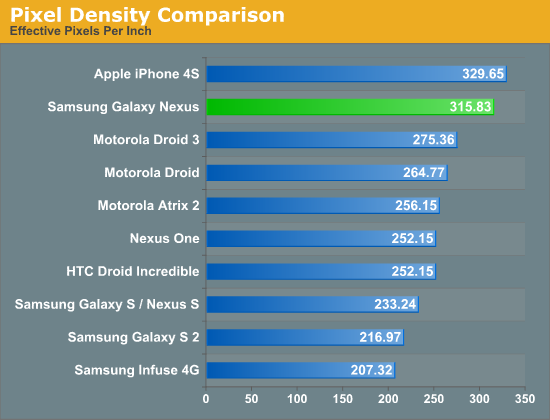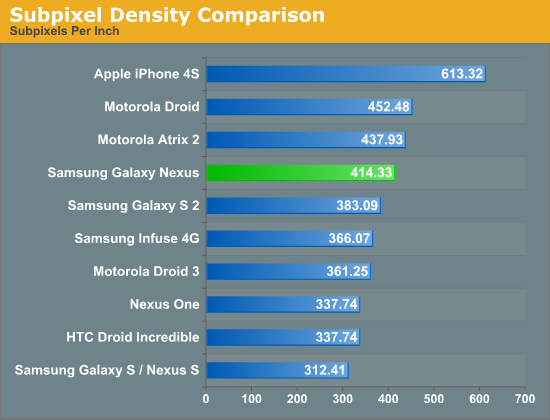Confirmed: Galaxy Nexus Includes PenTile
by Brian Klug & Jason Inofuentes on October 21, 2011 12:58 AM EST- Posted in
- Smartphones
- Samsung
- Ice Cream Sandwich
- Mobile
- AMOLED
- galaxy nexus
Though we've learned a lot about the Galaxy Nexus specifications already, one of the things that has remained a question thus far is whether its 4.65" 720p HD Super AMOLED display uses an RGB subpixel rendering layout or PenTile. We've now confirmed that the Galaxy Nexus display does in fact use RGBG PenTile, like all the Nexus devices to date. This isn't super surprising considering that Samsung has been pretty good about adhering to all the monikers it has gradually been tacking onto AMOLED. There are a number so far - 'super' connotes an optically bonded panel and digitizer stack, 'plus' connotes an RGB stripe, and now 'HD' connotes, well, 720p. HD Super AMOLED lacks Plus, and thus isn't an RGB stripe.
The next question is just what 4.65" HD Super AMOLED will look like, or whether the presence of PenTile will be as noticeable as previous AMOLED phones like the Nexus S / Galaxy S or Nexus One where it was arguably very noticeable. That said, at some subpixel density it should become difficult to impossible to notice PenTile's presence, it's just a matter of exceeding human visual acuity. Having not seen the Galaxy Nexus in person yet and given the absence of good macro shots of the display, we have put together a numerical comparison pitting the Galaxy Nexus panel up against some other common smartphone displays.
First up is a quick plot of the effective pixel density of some popular displays. Stated another way, this is the pixel density based on the manufacturer's stated logical resolution, which is also the resolution of Android's render target for the phone.

Note that this is the traditional means of reporting pixels per inch that we've published before. However, using this metric is just a bit misleading since it doesn't take into account the difference between 2 subpixel-per-pixel RGBG or RBGW PenTile versus the 3 subpixel-per-pixel RGB stripe. To make for an effective comparison, we've put together another plot where we take into account the presence of PenTile and report subpixel density.

Here things still look pretty good for the 4.65" HD Super AMOLED display, putting it just north of SGS2's Super AMOLED Plus display with an RGB stripe. I wager that if you were satisfied with the pixel density of SGS2 that the pixel density Galaxy Nexus actually won't be off-putting despite the presence of PenTile. In addition, hopefully some of the UI design considerations that come along with using PenTile (no vertical 1 pixel thick elements) have been taken into consideration from the outset for Ice Cream Sandwich. For true subjective impressions however, we'll have to wait and see.
Source: Data










152 Comments
View All Comments
ltcommanderdata - Friday, October 21, 2011 - link
If I'm not mistaken, AMOLED is well known to have oversaturated and exaggerated colors. If you want color accuracy you'd go with an IPS screen like the iPhone 4 uses. IPS computer monitors are what are used in the photography and other creative industries.Drewdog343 - Friday, October 21, 2011 - link
SAMOLED has it's advantages, color accuracy is not one of them..krumme - Friday, October 21, 2011 - link
You are right, sorry wrong formulation. They look a bit oversaturated to me too, but still gives the punch that is needed for a small screen imho. Its like colours have difficult escaping the small screens especially if there is light around. I dont know if others have the same impression.FATCamaro - Friday, October 21, 2011 - link
What about the fact that there is a much higher inter pixel distances in pentile. It's almost as if the pixels are smaller so there is more "black" in between the pixels. This makes it pretty bad as well.ImSpartacus - Friday, October 21, 2011 - link
It shouldn't matter unless pixel brightness varies based on pixel size.VTEChump - Friday, October 21, 2011 - link
Can someone calculate the subpixels per inch of the upcoming Galaxy Note? I'm too lazy to figure out the calculation:). The Note is a Super AMOLED display, 5.3", 1280x800 resolution.ImSpartacus - Friday, October 21, 2011 - link
And since modern American education doesn't provide citizens with a solid understanding of fractions and their important (but seemingly trivial) applications in manipulating unlike units of measurement, people still struggle with this stuff.GuinnessKMF - Friday, October 21, 2011 - link
Unfortunately your calculation is ignoring significant digits. For example the iPhone you calculated as 3.5" I'm assuming to get 329, but if you use 9cm you get 326, which is the stat provided by apple, which makes me assume that the screen is actually closer to 3.54". This is a minor difference, but you're displaying 5 significant digits on your graph, when you only have 2 significant digits in your source.JunkyJoe - Friday, October 21, 2011 - link
The new Galaxy S II HD, to be released along side the Galaxy S II LTE in Korea, also lacks the "Plus" RGB stripe. Meanwhile, the non HD Galaxy S II LTE retains the Plus with a 4.5-inch WVGA (800×480)http://www.samsungmobilepress.com/2011/09/28/Samsu...
Is the RGB stripe something Samsung is unwilling to implement across the board with any "HD" phone, not just the Nexus?
JasonInofuentes - Friday, October 21, 2011 - link
It's expensive. It'll happen in about a year. But for now this is pretty great. Really.